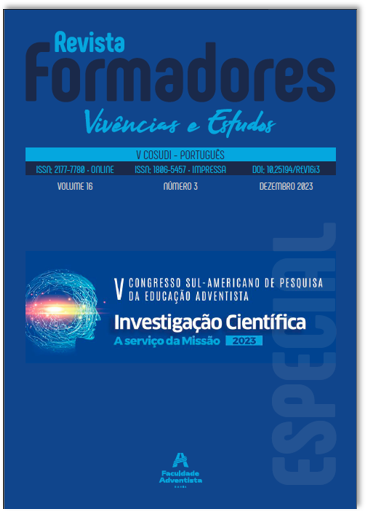YOUTUBE KIDS: A QUESTÃO DA LINGUAGEM
A QUESTÃO DA LINGUAGEM
DOI:
https://doi.org/10.25194/rf.v16i3.1737Keywords:
Language, Figures-themes, Youtube kidsAbstract
Considering that we are in the so-called “digital age”, children and teenagers have spent a lot of time in front of screens of computer, mobile or tablet, often without proper parental guidance, causing absorb very easily content they are exposed, and the ideology that is being transmitted. This paper aims to identify the language is being presented in two Youtube kids videos, since We seek to draw a parallel between the figures and themes presented in the videos selected for analysis, and thus understand whether the contents presented are considered suitable for the ages for which they are intended. After analyzing the relationship between figures and themes, according to semiotic theory, one can draw a framework of values that form the ideology of the studied videos.
References
AIX SISTEMAS. O uso do Youtube pelas crianças: potenciais e riscos. 2019. Disponível em:<https://educacaoinfantil.aix.com.br/o-uso-do-youtube-pelas-criancas/>. Acesso em 07 dez. 2019.
BARROS, D. L. P. Publicidade e figurativização. Alfa: Revista de Linguística, v. 47, n. 2, p. 11-31, 2004.
BEZERRA, K. 10 melhores youtubers infantis brasileiros. 2018. Disponível em:<https://www.estudokids.com.br/melhores-youtubers-infantis/>. Acesso em: 19 dez. 2019.
BRASIL. Ministério da Educação. Base Nacional Curricular Comum - B: educação é a base. Brasília: Ministério da Educação, 2017. 597p. Disponível em:< http://basenacionalcomum.mec.gov.br/images/BNCC_EI_EF_110518_versaofinal_site.pdf>. Acesso em: 07 dez. 2019.
CENTRO REGIONAL DE ESTUDOS PARA O DESENVOLVIMENTO DA SOCIENDADE DA INFORMAÇÃO-CETIC. Tic kids online Brasil. 2019. Disponível em:<https://cetic.br/pesquisa/kids-online/>. Acesso em: 02 dez. 2019.
CHAUÍ, M. S. Ideologia e educação. Educação e Pesquisa, v. 42, n. 1, p. 245-257, 2016.
DISCINI, N. Comunicação nos textos: leitura, produção, exercícios. São Paulo: Editora Contexto, 2005.
E-COMMERCE BRASIL. Crianças do Brasil passam 50% mais de tempo na internet do que a média global. 2018.
Disponível em:<https://www.ecommercebrasil.com.br/noticias/criancas-do-brasil-passam-50-de-tempo-mais-na-internet-do-que-media-global/>. Acesso em: 19 nov. 2019.
FALCÃO, S. B. Linguagem da internet: do virtual para o não-virtual. 2012. 10p. Disponível em:<http://www.fsma.edu.br/esfera/Artigos/Artigo_Sabrina.pdf>. Acesso em: 07 dez. 2019.
FIGUEIREDO, I. L. Procedimentos de tematização e figurativização na produção textual de alunos de terceiro grau. Revista do GELNE, v. 1, n. 1, p. 49-51, 1999.
HALLIDAY, M. K. A Functional Approach to Child Language. Cambridge, G. B., Cambridge University Press. In.: LEMOS, C. T. G. Interacionismo e aquisição da linguagem. D.E.L.T.A., v. 2, n. 2, 1986.
KLEIMAN, A. B. Preciso “ensinar” o letramento? Não basta ensinar a ler e a escrever?. Campins: Cefiel/ IEL/Unicamp, 2005.
MEIO&MENSAGEM. Os canais infantis mais influentes no Youtube. 2018. Disponível em:<https://www.meioemensagem.com.br/home/midia/2018/10/10/os-canais-infantis-mais-influentes-no-youtube.html>. Acesso em: 20 nov. 2019.
PIMENTEL, T. Tematização e figurativização e suas correlações com o plano de expressão em A invenção de Hugo Cabret 3D. PAPÉIS: Revista do Programa de Pós-Graduação em Estudos de Linguagens-UFMS, v. 20, n. 39, p. 136-151, 2016.
SELL, S. Chomsky e o inatismo cartesiano. Working Papers em Linguística, v. 6, n. 1, p. 7-29, 2002.
SILVA, L. M. G. et. al. Comunicação não-verbal: reflexões acerca da linguagem corporal. Revista Latino-Americana de Enfermagem, v. 8, n. 4, p. 52-58, 2000.
SIM-SIM, I. Desenvolver a linguagem, aprender a língua. In: CARVALHO, A. D. (Ed.). Novas Metodologias em Educação. Porto: Porto Editora, 2002, p. 197-226.
SOARES, M. Alfabetização e Letramento. 7. ed. São Paulo: Editora Contexto, 2003.
WHITE, E. G. Educação: Um modelo de ensino integral; tradução de Flávio Lopes Monteiro. Tatuí: Casa Publicadora Brasileira, 2008.


